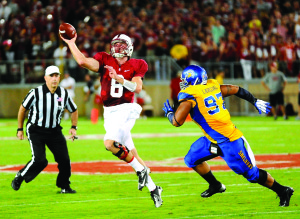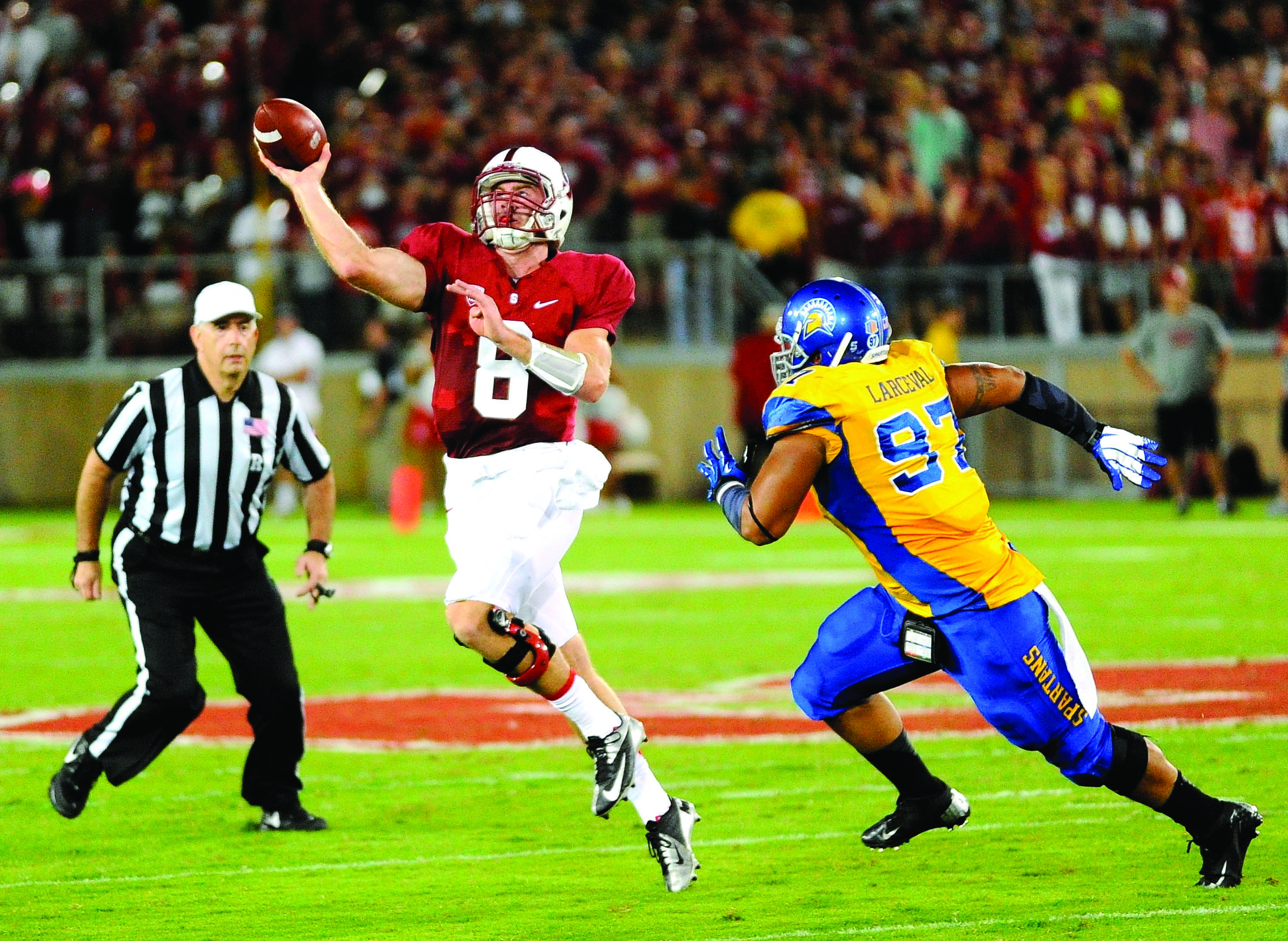Through two games, redshirt sophomore quarterback Kevin Hogan has completed 63 percent of his passes, down from nearly 72 percent last year. But those numbers don’t tell the whole story. Hogan has been throwing to a highly inexperienced receiver and tight end corps this season, and he has demonstrated improved accuracy with his deep throws, addressing arguably the most notable flaw in his game in 2012. With Arizona State’s strong rush defense coming to town, Stanford will likely need to throw the ball consistently this Saturday, begging the question: How much better—if at all—is the early-2013 Kevin Hogan than his late-2012 counterpart? We asked football writers Winston Shi, Do-Hyoung Park and David Cohn what they thought.

Winston: I’m going to take a bit of a cop-out: I wouldn’t be worried about Kevin Hogan’s progress, but it’s also too soon to tell how good he really is. The first thing to note is that Hogan is a good football player—he performed admirably last year, and, even if he’s still the same quarterback he was last year, Stanford will be decent on offense. He’s making more difficult throws this year, which I’m happy to see, but he did have a couple throws that could have been interceptions—he underthrew a deep ball to Michael Rector, and the ball actually bounced off an Army defender’s hands before Rector caught it for a touchdown. We also have to adjust to the level of competition he’s facing, which has not been elite; all in all, there’s a fair bit of mystery about Kevin Hogan.
Again, that’s not to say that Hogan is bad, as he has shown signs of progress. The fact that Hogan is making more impressive throws and reads is a good thing because it indicates David Shaw’s trust in his quarterback. Even in cruising victories against lower-level competition where little diversity in play calling was needed, Hogan earned much broader play calling than last year.
We’ll see how he does when Stanford actually needs to open up the playbook, though, as Stanford’s passing game isn’t humming at 100 percent yet. And why should it? David Shaw has indicated throughout his head coaching career that he doesn’t care at all about covering the spread, and a conservative game plan is probably a good idea; pollsters may care about margin of victory, but, at the end of the season, the only thing that matters is the win. If Stanford runs the table it will more than likely be in the national championship game. Might as well avoid anything that could risk that clean slate and shot at the national championship game. Might as well even avoid giving opponents any film worth studying.
Do: While I agree with Winston in that it is too early in the season to read too much into Hogan’s performance, I also think that it would be a disservice to both Hogan and offensive coordinator Mike Bloomgren to ignore that early returns on the new and improved Hogan have been promising at the very least.
What Hogan did in the second half of last season was just enough to complement an excellent defense and help the team win games. When he replaced Josh Nunes under center, he brought stellar accuracy on short passes to Zach Ertz, his safety valve, and still had his workhorse back in Stepfan Taylor. But the thing that made students and the media fall in love with Kevin Hogan was his escapability, an element that pushed the Cardinal offense forward en route to the Rose Bowl.
And looking at 2013 Kevin Hogan in these first two games, I think it is safe to say that over the offseason, he has added yet another element to his game, one that could potentially push the Cardinal offense over the top this year. This year, Hogan has been much more comfortable in the pocket and the coaches have let him throw the deep ball down the sidelines to a talented corps of receivers.
Call it adapting to losing both an All-American tight end and the school’s all-time leading rusher to the pros, but what I see is a young quarterback who has developed his game to the point where he can throw the deep ball comfortably, adding an explosiveness to the passing game that was sorely lacking last year. Sure, he’s young and he still makes mental mistakes and could work on his deep accuracy (particularly because he tends to overthrow the deep ball). But when he does hit his man 40 or 50 yards downfield, this offense looks a lot more like the Andrew Luck-led offense of old that makes Cardinal fans everywhere salivate.
How many 30-plus-yard completions did Hogan have all of last season? Just three. His season-long pass play? 43 yards. How many does he have in two games this season? Three already. His season-long pass play? 46 yards. Improvement is being made and explosiveness is being added to the Stanford offense. The escapability is still there, and this is one talented young man that is only getting better.
David: I believe that Kevin Hogan has definitely improved from the end of last season. From my perspective on the sidelines, I could tell that Hogan had an even greater mastery of the playbook in the home opener against San Jose State. He seamlessly moved through his progressions more consistently, he executed better footwork and, most strikingly, he stepped into his longer passes with greater frequency and with better balance.
This was particularly evident on Hogan’s first touchdown pass against San Jose State to junior wide receiver Devon Cajuste, when Hogan delivered a perfect 25-yard strike on a fly route that Cajuste caught in stride and ran into the end zone to complete the 40-yard score.
From a statistical perspective, the numbers also say that Hogan has been more effective this year. In his first two games, Hogan has a raw QBR, namely a QBR that has not been adjusted for the strength of the opponent, of 84.3 on a scale from 0 to 100, almost 20 points higher than his 2012 mark.
In addition, Hogan’s improvement in throwing the deep ball has led to a significant increase in his yards-per-attempt (YPA) from 7.21 in 2012 to 8.78 in 2013. Therefore, in spite of the drop in completion percentage over his first two games as compared to last year, Hogan has actually been even more productive throwing the football this season, leading to back-to-back dominant offensive displays from the Cardinal.
Do and David think that Winston took the easy pass in his “cop-out” of evaluating Kevin Hogan. Share your views with them at [email protected] and [email protected]. You can also contact Winston at [email protected].
